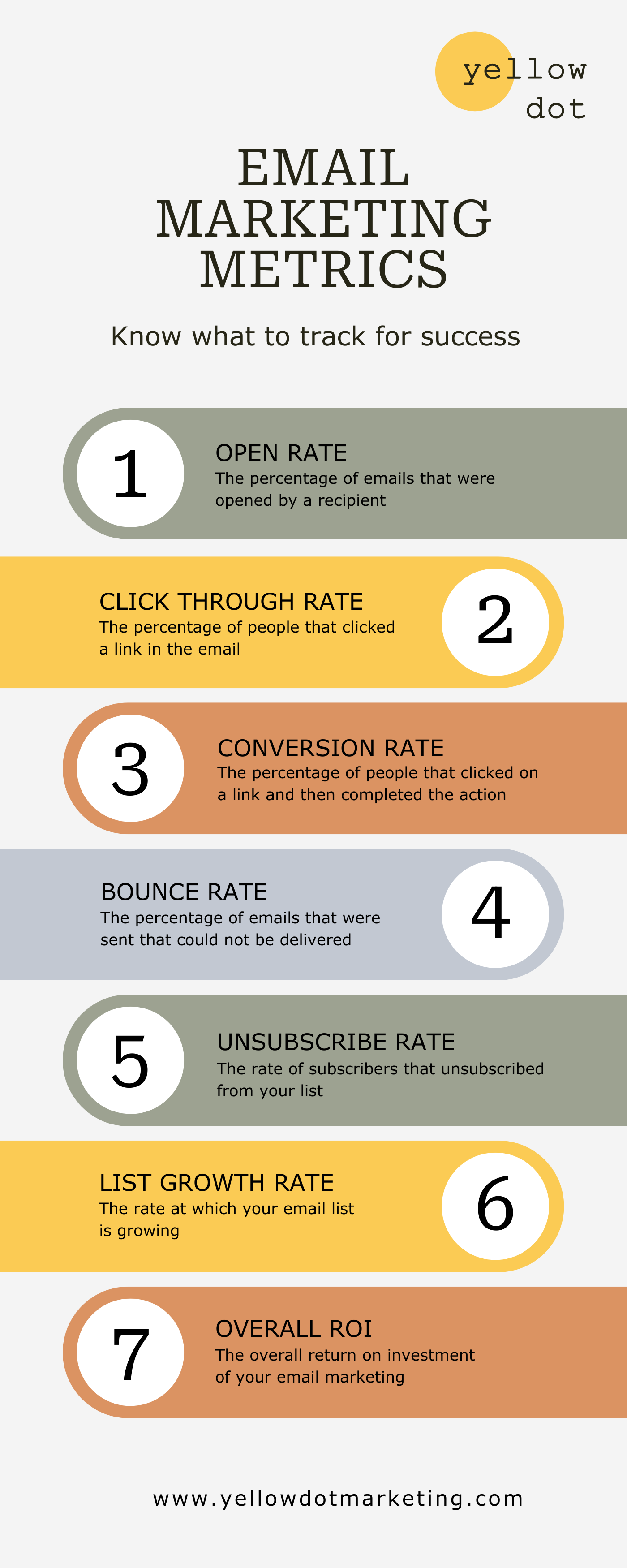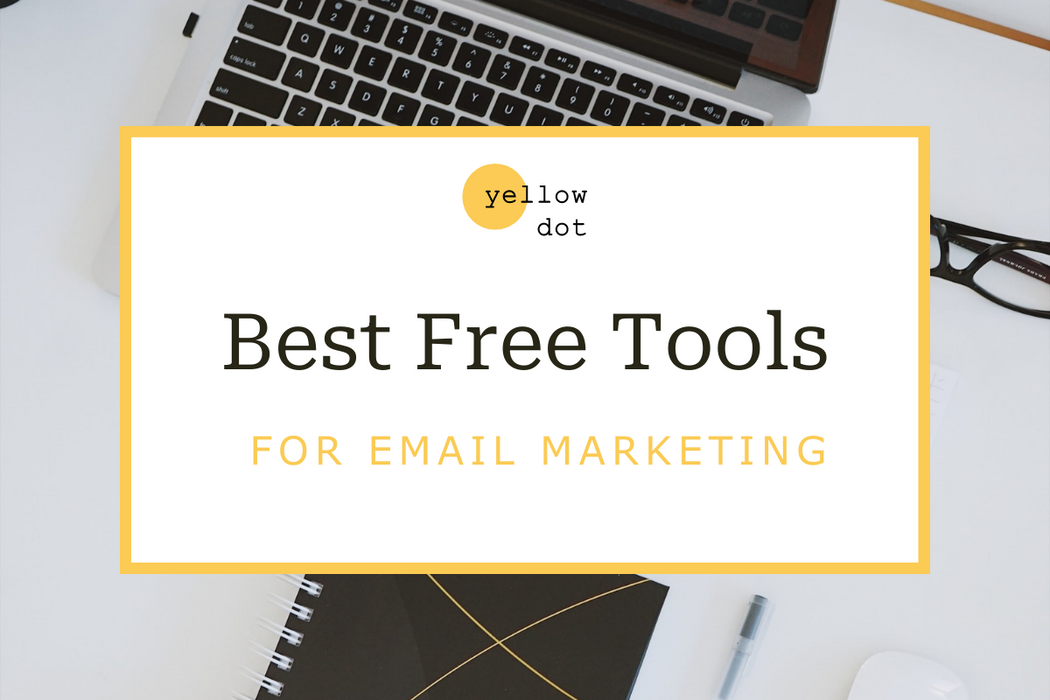Did you know that a strong and engaged email list can help grow your business?
Email marketing, when done right, allows you to communicate regularly with your audience of already-warm leads. Generating new leads that can be nurtured and converted into customers, increasing revenue and improving brand loyalty.
But how do you know if you’re doing it right?
If you’re not tracking your email marketing metrics then you will never know what’s working and whether you’re hitting your goals.
Read on for the top email marketing metrics you should be tracking – includes a handy infographic for quick review.
Email marketing advantages
Email marketing is considered to be one of the most efficient and profitable marketing channels. The return on investment can be as high as $40 for every $1 spent – take this figure with a pinch of salt, it’s based on global companies, both product and service based – but it does highlight email marketing advantages.
Read more here about why an email list is arguably your best business access.
Why you should track your email analytics
How do you know if something is working if you don’t track it?
Tracking email marketing analytics allows you to see patterns and trends. It identifies email campaigns that performed well. And emails that didn’t meet expectations – understanding what’s not hitting like a home run can be just as beneficial!
Once you have a clear understanding of your target audience and your content pillars you will be better positioned to anticipate what your audience wants to receive.
Tracking and analysing what your audience responds to is so valuable to monitor the successes of emails. This information can then be used to improve the email marketing strategy.
Common goals for email marketing

Generate More Leads

Increase Engagement

Increase Conversions
Email marketing KPIs to track to measure success
Email marketing KPIs might seem incomprehensible and too complicated to understand – but they are really just tools to help understand email marketing performance.
So what key things should you measure for performance?

Open Rate
This is the percentage of emails that were opened by a recipient.
It is good to review your open rates but it can be a misleading email marketing metric alone to measure success.
Open rates rely on tracking images. Many email users block images in their emails so the images don’t download. This means someone could open your email but it wouldn’t count towards your open rate.
Another factor that affects open rate accuracy is the update to Apple Mail iOS15. Apple now preloads emails on its own proxy server. This flags emails as opened, even if the recipient didn’t open them. This increases open rates for Apple mail users. Here’s a great article you can read about this update.
Open rates can be used as a comparative metric. Reviewing open rates from week to week will identify trends over a few months for example. Unless your list increases massively very suddenly, the Open Rates should be stable or spike with a particularly good email.
These issues with Open Rates mean you need to be more innovative to get clicks!
The email title gives a huge boost to email open rates. An intriguing and exciting title that encourages people to open your email is the first step to engaging people.
Click Through Rate
The percentage of people that clicked a link in the email.
Click Through Rate is an easy email marketing metric to calculate and is reliable. It allows you to see the performance of each email and monitor the click through rate over time.
It’s a very useful metric for determining the success of an A/B test email campaign, helping to highlight the best-performing title or content.
A good Click Through Rate is dependent on the company size, the industry and whether it’s B2B or B2C – there are so many factors that will determine a Click Through Rate. Generally, Click Through Rate of 2-5% click through rate is considered average and 10-20% is very good.

Conversion Rate
The percentage of people that clicked on a link and then completed the action.
If the main aim of your email marketing strategy is to generate leads and increase sales then this is an email marketing metric to monitor closely.
The Conversion Rate allows you to see who is following through to the desired result. It gives an indication of how many people want what you are offering – a particular offer or a survey for example.
Bounce Rate
This is the percentage of emails that were sent that could not be delivered.
There are two types of bounce rates – soft bounce and hard bounce.
Soft bounces are a temporary problem with a valid email address. If the inbox is full or there’s an issue with the server. Usually these emails are delivered at a later date or you can resend the email.
Hard bounces are due to an invalid or non-existent email address. Emails won’t ever be delivered to these addresses.
It’s best to permanently delete email addresses that hard bounce, otherwise they could harm your sender reputation. Hard bounce rates are one of the key factors used by internet service providers (ISPs) to determine an email sender’s reputation.
You don’t want to look like a spammer with lots of hard bounces so it is important to pay attention to this rate.

Un-subscribe Rate
This is the rate of subscribers that unsubscribe from your list after receiving an email.
The Unsubscribe Rate is not a hugely accurate email marketing metric either. Most people don’t bother to unsubscribe from emails once they don’t want to receive your emails anymore. They are more likely to just mark the emails as junk. So the Unsubscribe Rate doesn’t give an accurate reflection of the number of people not wishing to read your emails. But it does contribute to your list growth rate (below) so it’s a good metric to review monthly.
It is better to manage unengaged subscribers. Every 3-6 months, check which subscribers don’t open your emails and click on any links. Send a re-engagement campaign to see if they still want to be on your list. Give them the chance to respond and re-connect and advise them they will be removed from your list if they don’t click a link. This helps to keep your list clean and ensure the contacts are engaged.
List Growth Rate
This is the rate at which your list is growing.
The List Growth Rate shows if your email list is growing and an indication of how fast it’s growing. Measuring this email marketing metric allows you to see what methods are working to attract people onto your list and what you should try more of.
Overall Return on Investment
This is the overall investment of your email marketing.
The Overall ROI allows you to determine how much email marketing costs your business.
Understanding what type of leads your email marketing generates and the potential revenue from these leads, will help you see the success of email marketing with tangible results.

Conclusion
An email list is essential for all businesses. Growing an engaged audience will build loyalty and drive sales.
Analysing your email marketing metrics data over time will provide unique insights into your email marketing efforts.
Main email marketing analytics to review:
- Open Rate
- Click Through Rate
- Conversion Rate
- Bounce Rate
- Unsubscribe Rate
- List Growth Rate
- Overall ROI
Highlighting the successes will allow you to repeat these methods for future campaigns.
Start your list today, don’t miss out!
In the Effective Marketing Program you can learn how to be more stratgic with your marketing and maximise email marketing for you buisness and drive more sales. >>More details here.
Plan 12 months of content
Do you struggle with what to write to your subscribers each week?
You dread writing emails and keep putting it off.
Consistency is key with email marketing – the more you write to your audience the more data you will have to work out what they actually want to receive from you.
Download this free Trello board template to help you organise your content ideas and make the whole email marketing process easier.
Take control of your email marketing and feel confident that you won’t run out of email subjects ideas again!

Best Free Tools for Email Marketing
The best free tools for email marketing tools to boost sales without breaking the bank. Read more…

How to Build an Email List
Do you want to generate more leads for your business? Build an email list! Read more…

What are content pillars?
What if I told you there was an easier way to create and organise your content? Read more…

